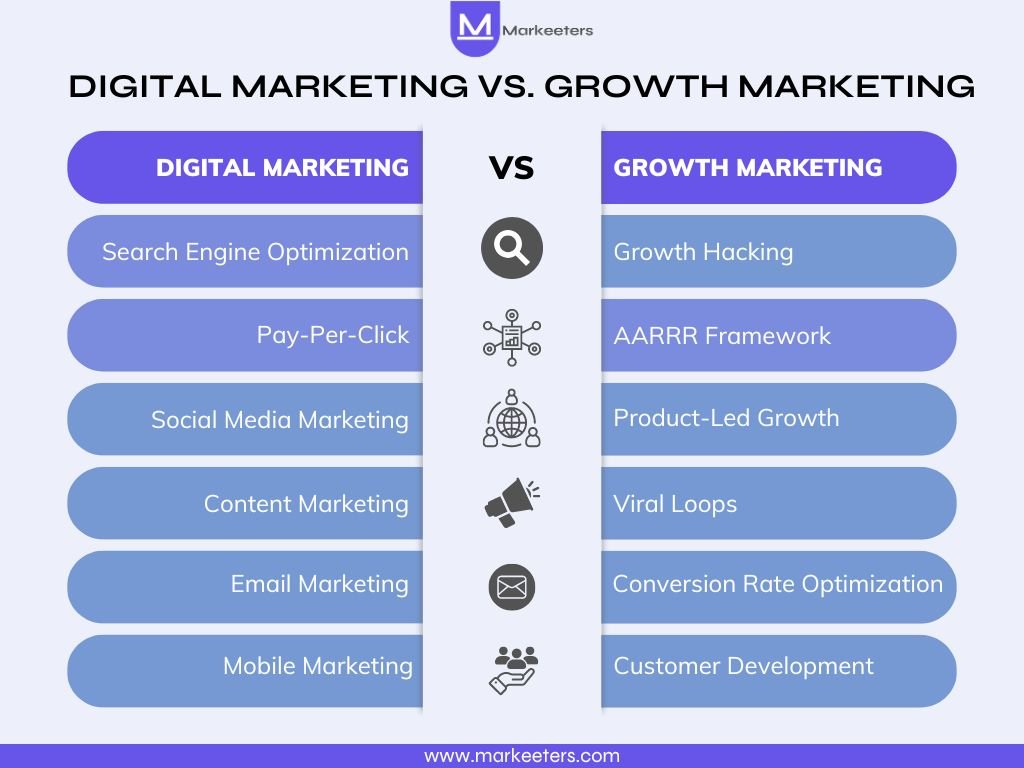The digital age has fundamentally changed marketing. Today, brands need strategies tailored for an “always on” world where consumers make purchases anytime, anywhere across devices.
But with endless options to reach customers online, how can you determine the smartest investment of resources? Two of the most effective modern marketing approaches are digital marketing and growth marketing. On the surface, they may seem similar – both utilize online channels to attract and convert customers.
However, at their core lie fundamental differences in philosophy and execution. In this blog, we’ll cut through the jargon and metrics to reveal the human element that should guide your strategy. You’ll learn how digital marketing builds long-term relationships versus growth marketing’s laser focus on rapid acquisition.
Our goal is to provide a framework you can use to determine if digital marketing, growth marketing, or a unified combination is the right solution to fuel your goals. Because in today’s data-driven landscape, the human touch matters more than ever.
What is Digital Marketing?
Digital marketing refers to promoting products or services using online channels. It encompasses a diverse array of strategies from search engine optimization to paid social media marketing. The core components include search, social, content, email, and mobile marketing.
As technology and consumer behaviour have evolved, digital marketing has expanded beyond basic website optimization to integrated, data-driven campaigns. The overarching goal is to attract qualified traffic, convert visitors, and analyze results through metrics and KPIs.
Properly implemented digital marketing drives brand awareness, generates leads and increases sales. With consumers predominantly online, digital marketing enables businesses to engage audiences on the channels where they spend the most time.
Also Read: SEO Freelancer vs. In-House SEO vs. SEO Agency: Which is Right for You?
What is Growth Marketing?
Growth marketing focuses on rapid, sustainable business growth as the primary objective. While digital marketing centres on driving conversions, growth marketing aims to scale the entire business to the next level. It prioritizes long-term gains over short-term wins.
Growth marketing applies data and key metrics to determine the best opportunities to invest resources for maximal growth. This requires a strong understanding of the customer lifecycle and leverages “growth hacking” experimentation to accelerate expansion.
Growth marketing is not limited to digital channels alone but takes an integrated, company-wide view. The focus is on metrics like customer acquisition, activation, retention, referral, and revenue known as the AARRR framework.
Growth marketing teams quickly test ideas, double down on what shows traction, and scale the ideas that generate results. For startups and small companies, growth marketing strategies can catalyze the speed and magnitude of expansion.
Also Read: 20 Powerful Growth Marketing Strategies
Digital Marketing vs. Growth Marketing
Let us know the difference between Digital Marketing and Growth Marketing with the help of their Key Strategies:

Key Strategies in Digital Marketing
Digital marketing utilizes a diverse array of strategies and channels to achieve results. Here are some of the most common and effective approaches:
Search Engine Optimization (SEO)
The process of optimizing website content and architecture so it ranks higher in organic search results. SEO is foundational for driving qualified visitors to websites from search engines like Google.
Pay-Per-Click (PPC)
Advertising model or Paid Search Marketing where marketers bid on keywords and pay only when ads are clicked. PPC provides a fast, measurable way to drive traffic and conversions. Google Ads and Facebook Ads are major PPC platforms.
Social Media Marketing
Promoting on social networks like Facebook, Instagram, Twitter, LinkedIn, and TikTok to raise brand awareness and engage specific audiences. Social media marketing allows direct interaction with customers.
Content Marketing
Content Marketing includes publishing valuable, relevant content like blogs, videos, and podcasts to attract and retain clearly defined audience segments. Typically centres on owned media channels.
Email Marketing
Sending targeted promotional or educational emails, typically in the form of email campaigns and newsletters. Email marketing allows personalized, automated communication.
Mobile Marketing
Any digital marketing tactics applied specifically in a mobile context across smartphones and tablets. Examples include SMS/MMS ads, mobile apps, and location-based push notifications.
When combined strategically as part of an integrated digital marketing plan, these provide businesses the digital presence, visibility, and engagement needed to thrive.
Also Read: Top 10 Best E-Commerce Platforms Worldwide
Key Strategies in Growth Marketing
Growth marketing focuses on rapid experimentation and scaling tactics that generate exponential business growth. Some core growth strategies include:
Growth Hacking
Testing non-traditional, innovative marketing tactics based on data and metrics. Growth hacking is designed to acquire users and accelerate growth in a short time with limited resources.
AARRR Framework
A data-driven process to increase customer Acquisition, Activation, Retention, Referral, and Revenue in a sustainable way. Growth marketers use this framework to funnel users through each stage.

Product-Led Growth
Building products designed to drive user acquisition, retention, and usage. Features like free trials and in-product education allow the product itself to become a growth engine.
Viral Loops
Creating self-reinforcing viral cycles where current users recruit future users via incentives, referrals, and social sharing. Each new user continues the loop.
Cost Per Acquisition (CPA)
Focusing ad spend on the metrics of customer acquisition cost and lifetime value. Low CPA relative to CLV indicates positive ROI and room to scale spend.
Conversion Rate Optimization (CRO)
Improving signup flows, site pages, and funnels to convert as many users as possible into customers and revenue. Small optimizations compound.
Customer Development
Proactively reaching out to users to understand pain points and iteratively improve the product experience. Drives retention and organic growth.
Lifetime Value (LTV)
Measure of the net profit contributed by a customer over their entire relationship. Maximizing LTV relative to CPA reveals opportunities to invest in growth.
Growth teams implement a tailored mix of these strategies to rapidly achieve critical milestones like product-market fit, exponential user acquisition, and reduced churn.
Choosing the Right Strategy
So when should businesses use digital marketing strategies versus growth marketing? Here are key factors to consider:

- Business Stage – For early startups, growth marketing should take priority to find product-market fit and explosive growth. More mature businesses can adopt digital marketing for sustainability.
- Business Goals – Digital marketing supports diverse goals from brand-building to lead gen. Growth marketing explicitly focuses on rapid, measurable growth.
- Target Audience – Is audience awareness already strong or still developing? Growth marketing requires an identified viable audience.
- Resources – Digital marketing can require significant ad budgets. Growth marketing is ideal for startups with not much funding initially.
- Time Horizon – Digital marketing provides flexibility for long-term brand-building. Growth marketing is focused on immediate traction and acceleration.
- Capabilities – Does your team have the technical expertise in analytics and attribution to execute growth strategies?
- Competition – In a highly competitive market, growth marketing can provide an advantage in outpacing rivals.
The ideal approach aligns your marketing strategy directly with core business goals and metrics. For pure customer acquisition and rapid expansion, growth marketing has the advantage. To increase brand awareness and loyalty over time across platforms, digital marketing is more appropriate.
Of course, businesses can also combine elements of both strategies for a “growth marketing” approach powered by digital channels. Testing and optimization will determine the most effective marketing recipe.
Also Read: How A Brand Marketer Takes Your Business to the Next Level?
Case Studies: Digital Marketing vs. Growth Marketing
Let’s look at some examples of successful implementation of digital marketing and growth marketing strategies:
Case Studies on Digital Marketing
- TOMS Shoes – By building content around its core mission of giving back, TOMS grew its brand awareness significantly. Their email list grew from 1,00,000 to over 2.5 million in 2 years.
- Freshly – Freshly, the prepared meal delivery service grew from 30,000 to 5,00,000 Instagram followers in 18 months with an optimized social media presence and engagement.
- Leadfeeder – Leadfeeder, the B2B lead generation tool increased organic traffic by 2X in 3 months by revamping its SEO and content strategy.
Case Studies on Growth Marketing
- Slack – By promoting its beta version as a “Preview release”, and incentivizing teams to create channels and groups, Slack drove 500% user growth in just 8 months after launch.
- Airbnb – Focusing on core metrics like listings growth, reviews, and professional photos allowed Airbnb to scale from 2,00,000 to over 1 million listings in 2 years.
- Dropbox – Referral incentives were key for Dropbox to gain 4 million users in 15 months. Each referral earned free storage space fueling viral growth.
Challenges and Considerations
While both marketing strategies clearly deliver results, some potential challenges to be aware of include:
- Achieving an integrated cross-channel experience with digital marketing can be difficult. Teams should avoid siloed campaigns.
- Growth marketing risks prioritizing growth above all else, sometimes at the expense of company culture or brand image.
- Legal and regulatory issues may arise if growth tactics are perceived as manipulative or unethical. Transparency is key.
- Digital marketing relies heavily on technology. Ad blockers, tracking restrictions, and AI can hamper results.
- The fast pace of growth marketing means teams must be comfortable with quick experimentation and iteration.
The key is continuous optimization and learning. Set clear KPIs to gauge effectiveness. Analyze both what is and isn’t working and adjust quickly. Leverage data and customer feedback to guide strategy. Consider combining digital and growth marketing approaches to balance brand building with sustainable growth.
Future Trends of Digital & Growth Marketing
Here are some notable trends and developments to expect in the future of digital and growth marketing:
- More integrated strategies across physical, digital, and social worlds as connectivity expands.
- Artificial intelligence and machine learning will allow more predictive modelling and hyper-personalization.
- Voice search and digital assistants open new SEO optimization opportunities.
- Augmented reality and virtual reality present new immersive brand experiences.
- Short-form video platforms like Instagram Reels and TikTok will dominate social media engagement.
- SMS/text messaging experiences a resurgence for timely communication.
- Subscriptions and membership models will become more prominent for retention.
- Privacy-centric strategies will be mandatory as regulations like GDPR emerge.
Keeping pace with the speed of innovation in the digital landscape is crucial. Leverage new technologies and channels while ensuring marketing efforts remain human-centric, ethical, and customer-focused.
Also Read: Is Pinterest Social Media or a Search Engine?
Conclusion
At its core, marketing has always been about making human connections and adding value. The proliferation of digital channels provides more opportunities to achieve this than ever before. However, it’s vital to not get lost in the technology and lose sight of the human element.
Both digital marketing and growth marketing offer data-backed paths to attracting and engaging customers in our digital world. Digital marketing builds relationships and brand affinity over time through valuable content and community engagement. Growth marketing accelerates acquisition by removing friction and incentivizing sharing.
The ideal approach depends on your business context and goals. For immediate growth traction, growth marketing provides focus. For long-term brand building, digital marketing delivers. More often, an integrated strategy balancing the two is best.
As digital evolves, creativity, empathy, and adaptability will remain the cornerstones of marketing success. Technology enables human connection at scale but cannot replace it. By keeping customers at the heart of your strategy, you’ll continue nurturing relationships that drive growth now and in the future.
FAQs: Digital Marketing vs. Growth Marketing
What is better than digital marketing?
There is no definitive “better” – digital marketing and growth marketing each have strengths depending on your goals. Growth marketing is focused specifically on rapid acquisition and maximizing viral growth. Digital marketing is broader, encompassing awareness, engagement, conversions, and loyalty.
An integrated strategy combining digital marketing’s versatility with the acceleration of growth marketing can be powerful for many businesses.
Is growth marketing the future?
Growth marketing is increasingly popular but unlikely to fully overtake digital marketing. Both have merits depending on context. Growth is well-suited to startups seeking product-market fit and viral growth. Digital marketing remains ideal for larger, established brands focused on multi-channel engagement and retention.
For many businesses, the future will involve strategically leveraging both approaches – using digital marketing to build audiences and growth marketing strategies to accelerate expansion. A data-driven, customer-centric approach is key to future success.
What are the risks of prioritizing growth marketing?
An overemphasis on growth at all costs can lead to poor customer experiences, reliance on manipulative tactics, and communication that damages brand identity. Companies shouldn’t lose sight of the human element and their values in the drive for acquisition.
How can digital marketing and growth marketing work together?
There are natural synergies between digital and growth marketing. For example, using content marketing to attract audiences, and then growth strategies to convert them into customers. Or acquisition through growth channels and then brand building through digital channels. Integrated properly, they balance long-term vs. short-term focus.
Is growth marketing more affordable than digital marketing?
Not necessarily. Tactics like paid search and influencer partnerships can have high costs. Optimizing viral sharing, referrals, and retention are relatively low-cost growth strategies. Budget-friendly options exist in both realms.
Is growth marketing hard?
Growth marketing is data-driven and fast-paced which can make it challenging. Testing new tactics quickly and knowing which metrics to focus on takes skill. But starting with low-risk experiments and leveraging what worked for other brands can make it more accessible. Patience and persistence are key.
What is the difference between growth marketing and SEO?
SEO is a digital marketing channel focused specifically on improving search engine rankings through tactics like keyword optimization. Growth marketing is a broader strategic approach focused on rapid acquisition and viral growth across channels including SEO as well as paid ads, referrals, influencers, etc.
Is digital marketing STEM or not?
Digital marketing leverages data, analytics, design, and technology so it relies heavily on STEM skills. Technical abilities in areas like data analysis, programming, UI/UX, and automation provide an edge for digital marketers using platforms and tools powered by tech innovations.
Should I switch to digital marketing?
If your interests and strengths align with digital channels, data analysis, and technology, a career pivot into digital marketing could be promising. Digital spending continues rising so digital marketing skills are highly valued. Ensure you pursue proper training and certifications to stand out.
What do growth marketers do?
Growth marketers specialize in acquisition and viral growth through rapidly testing and optimizing tactics related to product optimization, user psychology, conversion rates, retention, referrals, and more. Analytical and creative skills are required.





